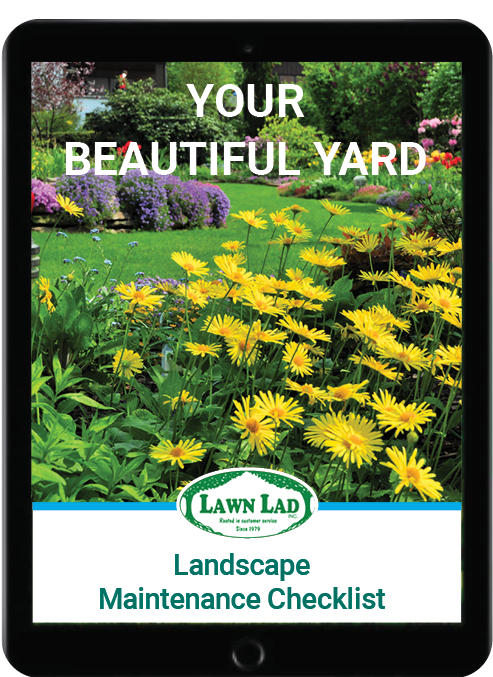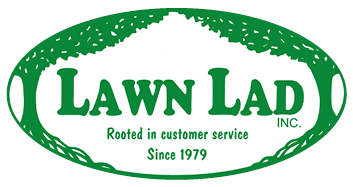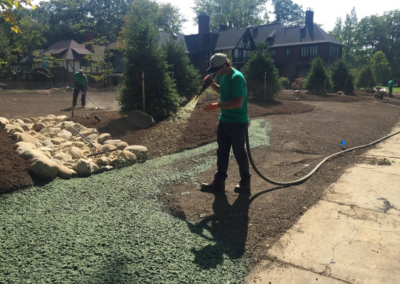new lawn
installation
WHEN IS A NEW LAWN
INSTALLATION NECESSARY?
A new lawn is necessary when the current conditions and defects require more than a lawn renovation or lawn care services to correct. Depending on the severity of the defects, the overall area, and goals for the lawn, we’ll recommend a time tested and proven installation approach for a top-performing lawn. Coupled with the optional Lawn Development Program, you’re guaranteed to have your field of dreams.
A new lawn installation generally includes killing the existing lawn, removing or cultivating the lawn, grading for ideal slope and drainage, adding new top soil, finishing grade for a smooth lawn, and installing hydroseed.
If you’re making the investment in a new lawn, now would be the ideal time to consider…
-
- Installation of an in-ground irrigation system
- Remove stumps or other undesirable landscape elements
- Reduce, add or or adjust bed areas and bed lines
- Decide if drainage or underground utilities need to be installed
LAWN LAD OFFERS 3 TYPES OF LAWN INSTALLATION PROCESSES:
1 – Cultivation Process
When defects are minimal, the existing soil is healthy, and/or your budget is limited, the Cultivation Process may work well. After killing the lawn, the soil is cultivated to incorporate the dead turf, the area is graded, and supplemental top soil is added where necessary to prepare the lawn for hydroseeding.
2 – Remove and Replace Process
The most thorough approach to installing a new lawn requires a larger financial investment. After killing the lawn, the top layer of sod is cut out, removed and hauled from the property. New soil to replace the sod plus additional soil is installed, finish graded, and hydroseeded.
This method is preferred when removing an old creeping bentgrass lawn with heavy thatch, and where more significant defects require more grading and corrective work.
3 – Sod Installation Process
Sod installations offer the advantage of providing an established lawn much quicker than seeding. While the preparation work before installation is the same whether you choose sod or seed, there are notable differences between the two methods.
-
- Establishment Time: Sod is mature grass that is grown and established on a farm, which gives you an instant lawn upon installation. Once the roots are established (generally in four to six weeks), the lawn can be used like normal. Seeding requires time for the grass to germinate, grow, and establish itself, which means it will take longer before your family can actively use the lawn.
- Cost: Sod installations typically cost around 50% more or even higher compared to seed installations because of the cost of the sod and the labor to install it.
- Irrigation Requirement: We only recommend sod installations for properties with an in-ground irrigation system. This ensures that the sod receives adequate water during the critical establishment period, promoting healthy growth and minimizing the risk of drying out.
While sod installations offer the advantage of instant results and a mature lawn, they come at a higher cost compared to seeding.
Other Options
Other installation options may include:
-
- A hybrid between a lawn renovation and new lawn where the grass is cut short, the lawn receives a skim coat of soil and new seed is installed. This may be performed over a live lawn that will recover or after killing the lawn. The volume of new soil is limited and does not involve cultivating.
- Spot seeding large areas to correct depressions and fill in bare spots with topsoil and then hydroseeding.
Common Q&A’s about new lawn installations
Why do you hydroseed?
A hydroseed mixture is a blend of about 10 ingredients mixed in water to create a slurry that is pumped through a hose and applied to the lawn. This results in faster and more complete germination while minimizing erosion and preventing weeds. The same process is not possible and fewer benefits are realized when installing seed dry. Unlike straw, which may contaminate your new lawn with weed seeds and blow around, Hydromulch is free of contaminants and is cost effective.
What type of grass seed do you use?
TTTF (Turf Type Fall Fescue) is a seed for the times—it’s low maintenance and is adaptable, drought and shade tolerant, wear and disease resistant, and establishes quickly. TTTF works well with shady lawns in Cleveland Heights and Shaker Heights.
We purchase only “A” program varieties evaluated by NTEP (National Turfgrass Evaluation Program) through our seed supplier to ensure the best quality seed selections with no weed seeds or contaminants.
When is the best time to seed - Spring or Fall?
Late summer to early fall is the best time to install a new lawn. Temperatures are cooling for ideal seed development, Mother Nature helps with rain to ensure adequate moisture, and the pressure from grassy annual weeds is in the rearview mirror. A “fall” seeded lawn will provide the best results as more complete germination will occur and roots will have a chance to develop before the next summer.
It may be absolutely necessary to seed in the spring or summer, but it’s less desirable since the roots are less developed going into summer, which requires more water; and if temperatures are over 85°·F, seed germination and development slows. Areas that germinate and develop more slowly are prone to having grassy and broadleaf weeds take over, requiring herbicides and additional effort to overcome. Generally we only advise doing necessary lawn repairs in the spring, waiting until fall to invest in large scale seeding projects.
Can I seed in the summer?
While small seeding projects can be undertaken in the summer if absolutely necessary, it’s not advisable until temperatures cool. Seeding during the summer poses several risks to new seedlings, including increased risk of drying out, higher susceptibility to disease, greater likelihood of annual grassy weeds, and poor seed development due to the heat. To minimize these risks and ensure successful germination and establishment, it’s generally best to avoid seeding until at least mid- to late August, when temperatures begin to moderate and conditions become more conducive to healthy seed growth. By waiting until temperatures cool, you can significantly improve the chances of a successful seeding project and promote the long-term health and vitality of your lawn.
What happens after installation?
Once the seed is planted, the first goal is thorough and complete germination. This takes diligent watering and a little help from Mother Nature with cool temperatures and soft rains. The first fall is like having a newborn baby, requiring close and attentive care. By spring, your new lawn is like a toddler, becoming a little more sturdy and independent, but not quite there. Through summer and into the fall when the lawn is one year in the ground, the lawn is in its adolescence and requires less direct attention, but benefits from proper maintenance practices. The lawn reaches the true-leaf stage of development and is fully established about two years after seeding.
The growth and development of the new lawn takes time, and requires the proper care and attention to ensure the return on your investment. You will receive after care instructions as a part of the project. Our LDP (Lawn Development Program) will help ensure you realize your field of dreams.
Is an irrigation system necessary?
Setting up hoses and sprinklers connected to a timer is an option; however, an in-ground irrigation system is an excellent tool to help establish a new lawn and maintain it for years. The additional investment is not necessary if you have the ability to water manually. If you have a larger lawn area, variable schedule, or lack the time to commit to a regular watering schedule, an irrigation system is recommended.

DOWNLOAD OUR FREE CHECKLIST
Get a season-by-season DIY checklist for your lawn and yard with our FREE Landscape Maintenance Checklist!
Are you ready to love
your landscape?
Rooted in Customer Service Since 1979

Office/Shop Address: 441 South Green Road, South Euclid, Ohio 44121
Mailing Address: 471 Chagrin River Road, Cleveland, Ohio 44040
(216) 371-1935 • info@lawnlad.com
©Lawn Lad, Inc. 2023


